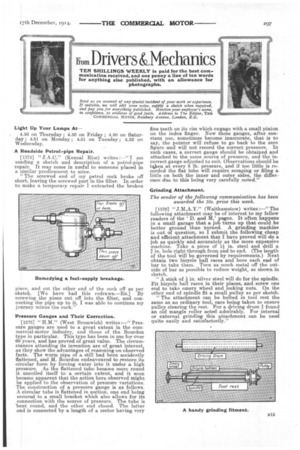TEN SHILLINGS WEEKLY is paid for the hest corn. munication
Page 19

If you've noticed an error in this article please click here to report it so we can fix it.
received, and one penny a line of ten words for anything else published, with an allowance for photographs.
Send us on account of any speeial incident of your work or experience. If suitable, we will edit your notes, suPtly a sketch when required, and pay you for everything published. Mention your onPloyer's *tome, in confidence, as evidence of good faith. Address to The Editor, THE COMMERCIAL mama, Rosebery Avenue, London, E.C.
Light Up Your Lamps At 4.50 on Thursday ; 4.50 on Friday ; 4.50 on Saturday; 4.51 on Monday ; 4.51 on Tuesday ; 4.52 on Wednesday.
A Roadside Petrol-pipe Repair.
[1574.] " J.A.O." (Kensal Rise) writes :—" I am sending a sketch and description of a petrol-pipe repair. It may come in useful to someone placed in a similar predicament to mine.
"The screwed end of my petrol cock broke off short, leaving the screwed part in the filter. In order to make a temporary repair I extracted the broken piece, and cut the other end of the cock off as per sketch. [We have had this redrawn.—En.] By screwing the piece cut off into the filter, and connecting the pipe up to it, I was able to continue my journey minus the cock."
Pressure Gauges and Their Correction.
[1575] "TIM." (West Bromwich) writes :—" Pressure gauges are used to a great extent in the commercial-motor industry, and those of the Bourdon type in particular. This type has been in use for over 430 years, and has proved of great value. The circumstances attending its invention are of great interest, as they show the advantages of reasoning on observed facts. The worm pipe of a still had been accidently flattened, and M. Bourdon endeavoured to restore its circular form by forcing water into it under a high pressure. As the flattened tube became more round it uncoiled itself to a certain extent, and it soon became apparent that the action here observed might be applied to the observation of pressure variations.
• The construction of a pressure gauge is as follows, A circular tube is flattened in section, one end being secured to a small bracket which also allows for its connection with the source of pressure. The tube is -bent round, and the other end closed. The latter end is connected by a length of a sector having very fine teeth on its rim which engage with a small pinion on the index finger. Now these gauges, after constant use, sometimes become inaccurate, that is to say, the pointer will refuse to go back to the zero figure and will not record the correct pressure. In such cases, a correct gauge should be obtained and attached to the same source of pressure, and the incorrect gauge adjusted to suit. Observations should be taken at every 5 lb. pressure, and if too little is recorded the flat tubo will require scraping or filing a little on both the inner and outer sides, the difference due to this being very carefully noted."
Grinding Attachment.
The sender of the following communication has been awarded the 108. prize this week.
[1576] " J.M.A.Y." (Waltharnstow) writes :—" The following attachment may be of interest to my fellow readers of the 'D. and M.' pages. It often happens in a small garage that a job turns up that could be better ground than turned. A grinding machine is out of question, so I submit the following cheap. and efficient attachment that I have proved will do a job as quickly and accurately as the more expensive machine. Take a piece of 1i in. steel and drill a in. hole right through from end to end. (The length of the tool will be governed by requirements.) Next obtain two bicycle ball races and bore each end of bar to take them. Turn as much metal off the outside of bar as possible to reduce weight, as shown in sketch.
"A stick of in. silver steel will do for the spindle. Fit bicycle ball races in their places, and screw one end to take emery wheel and lacking nuts. On the other end of spindle fit a small pulley as per sketch. "The attachment can be bolted in tool rest the same as an ordinary tool, care being taken to ensure
pulley clearing the rest. For a driving drum I found an old mangle roller acted admirably. For internal or external grinding this attachment can be used quite easily and satisfactorily."




















